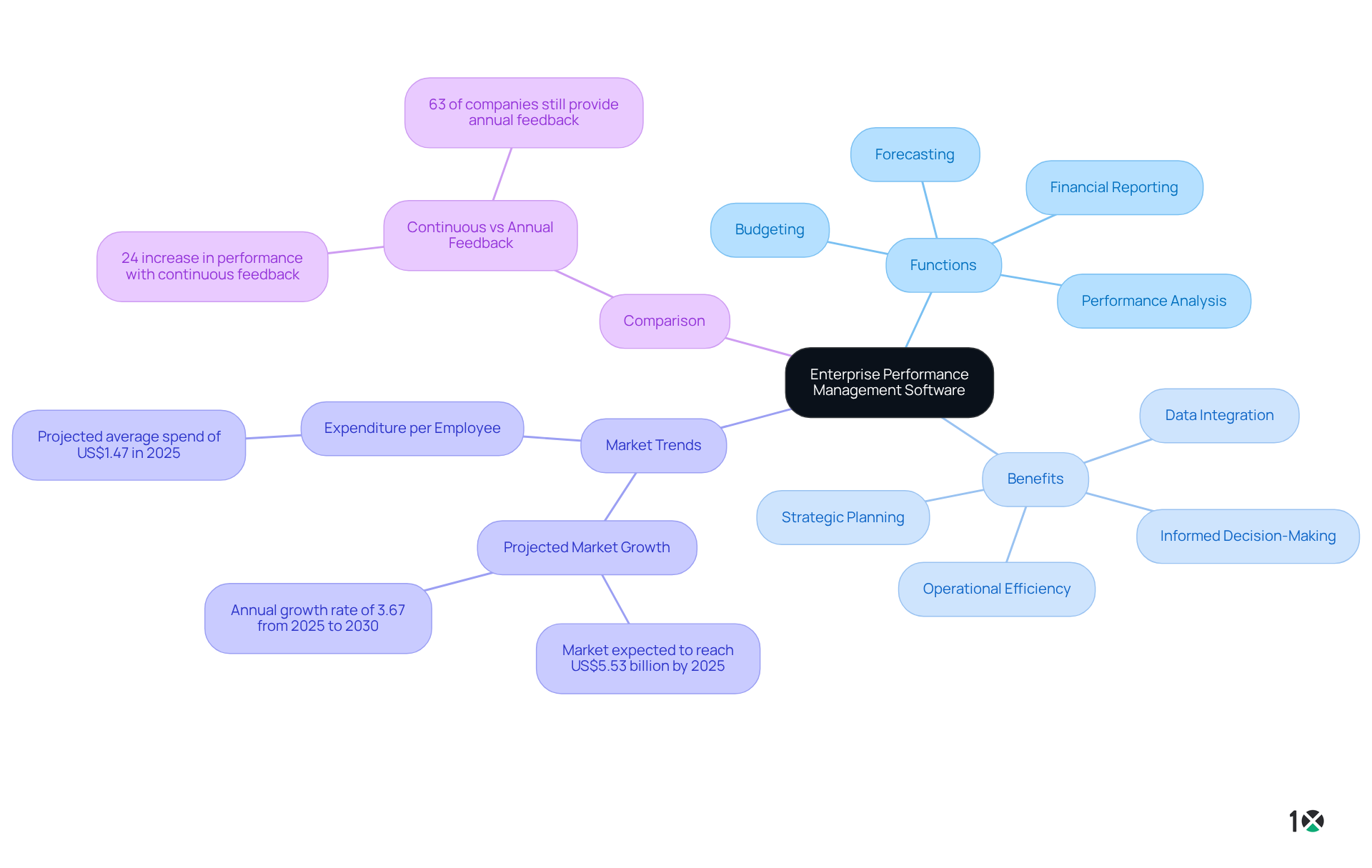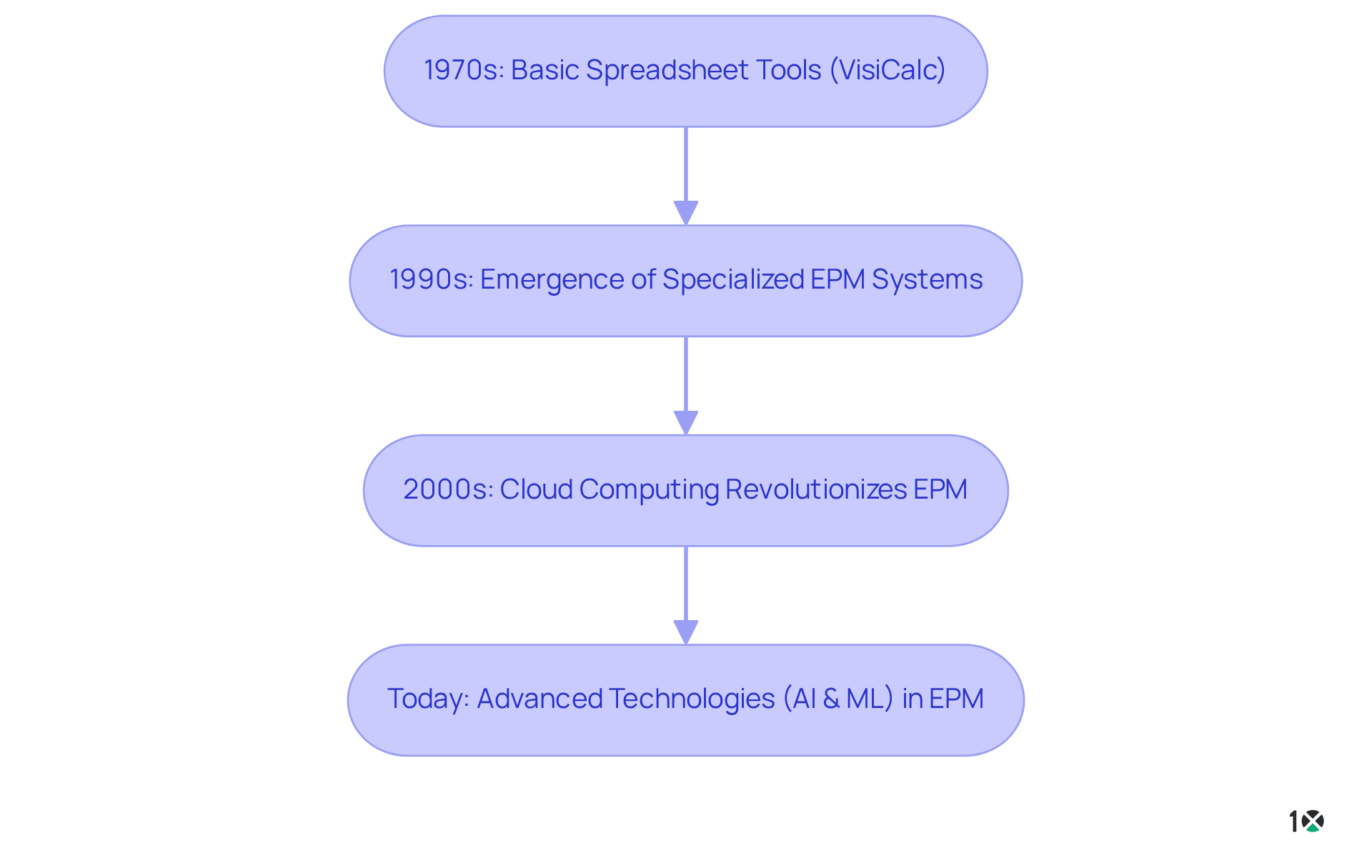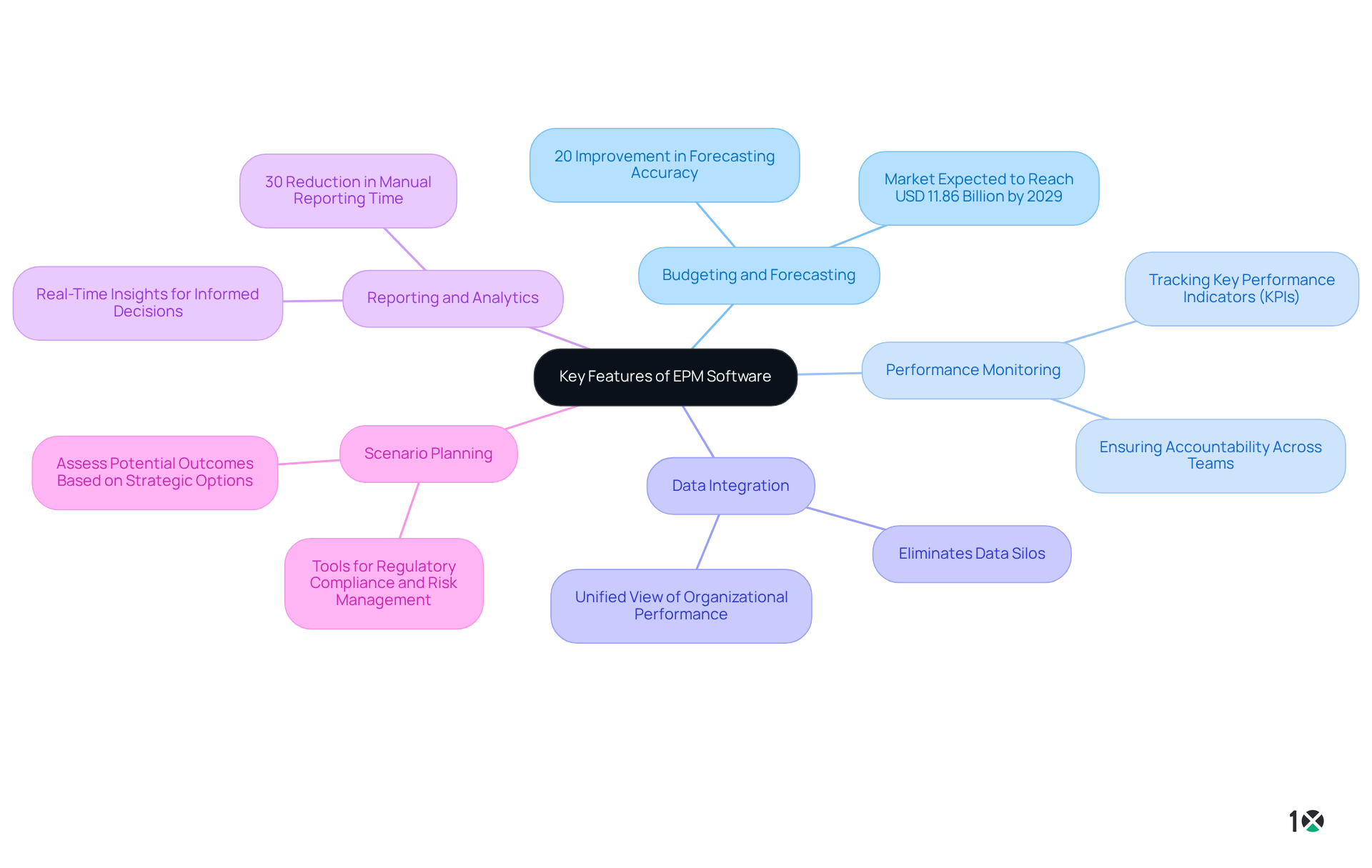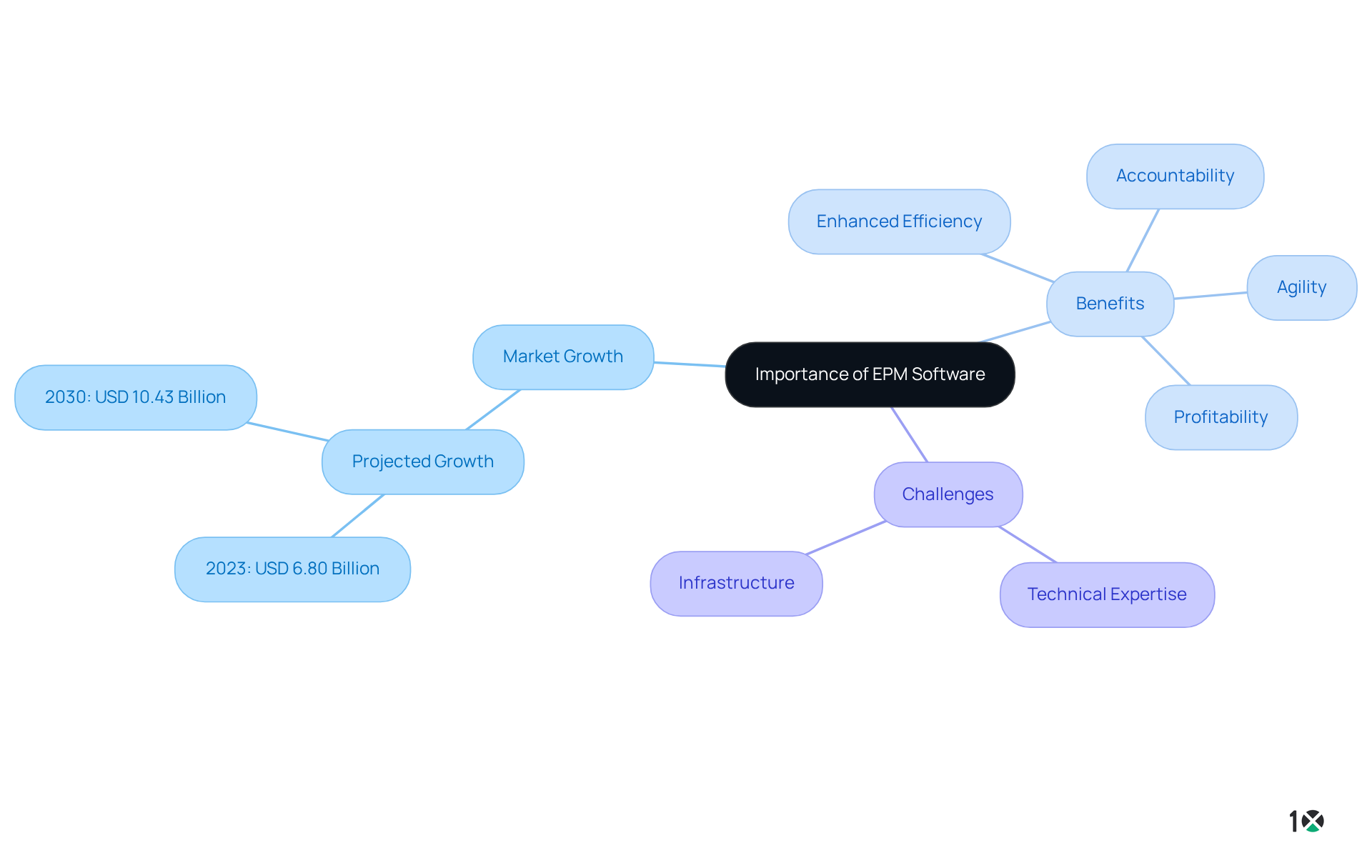Overview
Enterprise Performance Management (EPM) software is essential for organizations seeking to enhance their planning, monitoring, and performance management capabilities. By integrating budgeting, forecasting, and reporting tools, EPM aligns daily operations with strategic goals. This alignment not only fosters data-driven decision-making but also leads to significant improvements in performance and efficiency. Notably, organizations employing continuous management systems have experienced a remarkable 24% increase in performance. Clearly, adopting EPM is a strategic move that can transform organizational effectiveness.
Introduction
Enterprise performance management (EPM) software has emerged as a vital asset for organizations seeking to enhance operational efficiency and align strategies with long-term goals. This suite of tools streamlines budgeting, forecasting, and performance analysis while integrating data from various sources to provide critical insights into an organization’s financial health. However, as traditional performance management methods clash with modern data-driven approaches, a pressing question arises:
- How can organizations effectively navigate this transition to fully leverage the transformative potential of EPM software?
By addressing this challenge, organizations can unlock new levels of performance and strategic alignment.
Define Enterprise Performance Management Software
Enterprise performance management software represents a powerful suite of tools and processes designed to aid organizations in planning, monitoring, and managing their overall performance. Encompassing essential functions such as budgeting, forecasting, financial reporting, and performance analysis, EPM enables entities to harness data from diverse sources. This integration provides critical insights into operational efficiency and financial health, fostering informed decision-making and strategic planning.
The true value of EPM lies in its ability to align daily operations with long-term organizational goals, ensuring that every department is unified in pursuing shared objectives. Companies that have embraced continuous performance management systems have reported a remarkable 24% increase in performance compared to those relying solely on annual reviews. This statistic underscores the effectiveness of modern performance management approaches.
Despite this progress, it is noteworthy that 63% of companies continue to provide annual performance feedback, highlighting the stark contrast between traditional and contemporary methods. As organizations increasingly prioritize data-driven decision-making, the adoption of enterprise performance management software solutions is projected to surge, with the market anticipated to reach US$5.53 billion by 2025. Additionally, the expected average expenditure per employee in the enterprise performance management software market is forecasted to be US$1.47 in 2025, reflecting the growing recognition of enterprise performance management software’s role in enhancing organizational performance.
Moreover, EPM not only augments management insights but also builds upon ERP’s operational data, enriching the overall strategic framework for businesses. This integration is essential for organizations aiming to thrive in an increasingly competitive landscape.

Trace the Evolution of EPM Software
The evolution of Enterprise Performance Management (EPM) applications commenced in the 1970s with the introduction of basic spreadsheet tools such as VisiCalc, which facilitated financial reporting and budgeting.
As organizations recognized the need for more integrated solutions, the 1990s saw the emergence of specialized EPM systems that automated numerous processes, thereby enhancing efficiency and precision.
The advent of cloud computing in the 2000s transformed EPM software, enabling real-time data access and collaboration across departments. This shift not only streamlined operations but also facilitated the transition from traditional spreadsheet methods to more sophisticated EPM systems.
Today, EPM solutions capitalize on advanced technologies, including artificial intelligence and machine learning, empowering organizations to perform predictive analytics and scenario modeling, which significantly enhances their strategic planning capabilities.
The growth of cloud-based EPM solutions has been remarkable, signaling a movement toward more flexible and scalable systems that adapt to the evolving demands of enterprises.
According to industry reports, the adoption of enterprise performance management software has surged by over 50% since 2010, underscoring its importance in modern corporate landscapes.
Expert insights reveal that these advancements have enabled organizations to generate agile forecasts across all business lines, further boosting their operational effectiveness.

Identify Key Features and Functions of EPM Software
Key features of EPM software include:
-
Budgeting and Forecasting: EPM tools facilitate the creation of detailed budgets and forecasts, empowering organizations to strategically plan for future financial performance. Research indicates that organizations utilizing advanced budgeting tools experience a 20% improvement in forecasting accuracy, significantly enhancing their financial planning capabilities. Furthermore, the market for enterprise performance management software is anticipated to reach USD 11.86 billion by 2029, underscoring the increasing significance of these solutions in contemporary corporate settings.
-
Performance Monitoring: EPM applications enable the tracking of key performance indicators (KPIs), essential for assessing progress against strategic goals. This capability is crucial for maintaining alignment with business objectives and ensuring accountability across teams.
-
Data Integration: Enterprise performance management software plays a crucial role in data integration by consolidating data from diverse sources, offering a unified view of organizational performance. This integration is vital for accurate reporting and informed decision-making, as it eliminates data silos and enhances visibility across departments. The API-first strategy of enterprise performance management software further enables seamless integration with core systems such as e-commerce and supply chain management.
-
Reporting and Analytics: Advanced reporting capabilities allow for real-time insights and analysis, assisting stakeholders in making informed decisions. Organizations leveraging these tools report a 30% reduction in time spent on manual reporting processes, allowing for a more strategic focus. Additionally, EPM tools automate budgeting, strategy, and financial planning, streamlining these critical functions.
-
Scenario Planning: The use of enterprise performance management software facilitates scenario modeling, enabling entities to assess potential outcomes based on various strategic options. This functionality is vital for proactive decision-making, as it allows businesses to prepare for various market conditions and adjust strategies accordingly. Furthermore, EPM solutions assist entities in navigating regulatory compliance and risk management, offering tools for financial reporting and compliance tracking.
These attributes collectively empower entities to enhance their operational efficiency and strategic alignment, making enterprise performance management software indispensable for contemporary financial management.

Explain the Importance of EPM Software for Organizations
Enterprise performance management software is indispensable for organizations striving to align operational activities with strategic objectives. These tools provide real-time insights into performance metrics, empowering organizations to make informed, data-driven decisions that significantly enhance efficiency and profitability. Market projections indicate that the market for enterprise performance management software is set to expand from USD 6.80 billion in 2023 to USD 10.43 billion by 2030, underscoring the growing recognition of its value in the corporate landscape.
EPM solutions foster collaboration across departments, ensuring that all teams are united in their pursuit of common goals. In today’s competitive environment, the ability to swiftly adapt to market changes and optimize resource allocation is crucial. Organizations that effectively implement enterprise performance management software can expect to see enhancements in financial performance, increased accountability, and improved agility in navigating challenges. For instance, Hypercube Consulting’s deployment of EPM solutions for Malaysia Airlines and Singapore Post exemplifies how these tools can boost efficiency and streamline processes.
As highlighted by industry leaders, “EPM fosters agility in responding to market changes, optimizes resource allocation, and improves financial accuracy and compliance.” However, it is essential to recognize that the successful implementation of EPM systems may be impeded by a lack of technical expertise and infrastructure, both critical for customizing the system to align with business processes. Overall, the transformative potential of enterprise performance management software tools is evident in the substantial gains in profitability and operational efficiency reported by organizations leveraging these systems.

Conclusion
Enterprise performance management (EPM) software is a critical asset for organizations aiming to enhance performance through strategic alignment and data-driven decision-making. By integrating various functions such as budgeting, forecasting, and performance monitoring, EPM tools empower businesses to achieve long-term objectives while maintaining operational efficiency. The shift from traditional performance management methods to modern EPM solutions fosters collaboration across departments and significantly boosts overall performance metrics.
The evolution of EPM software is noteworthy, transitioning from basic spreadsheet tools to sophisticated, cloud-based solutions that leverage advanced technologies like artificial intelligence. Key features such as scenario planning, data integration, and real-time analytics illustrate how EPM software enhances organizational agility and financial accuracy. Furthermore, the projected growth of the EPM market underscores its increasing importance in the corporate landscape, with organizations recognizing the substantial benefits these systems offer.
In conclusion, embracing enterprise performance management software is essential for organizations seeking to thrive in a competitive environment. By leveraging these tools, businesses can optimize resource allocation, improve accountability, and swiftly adapt to market changes. As the landscape of performance management continues to evolve, the call to action is clear: organizations must invest in EPM solutions to unlock their full potential and drive sustainable growth.
Frequently Asked Questions
What is enterprise performance management (EPM) software?
Enterprise performance management software is a suite of tools and processes that help organizations in planning, monitoring, and managing their overall performance. It includes functions such as budgeting, forecasting, financial reporting, and performance analysis.
How does EPM software benefit organizations?
EPM software enables organizations to harness data from various sources, providing critical insights into operational efficiency and financial health. This fosters informed decision-making and strategic planning, aligning daily operations with long-term organizational goals.
What impact does continuous performance management have on organizational performance?
Companies that implement continuous performance management systems have reported a 24% increase in performance compared to those that rely solely on annual reviews, highlighting the effectiveness of modern performance management approaches.
What percentage of companies still provide annual performance feedback?
Despite advancements in performance management, 63% of companies continue to provide annual performance feedback, indicating a contrast between traditional and contemporary methods.
What is the projected market value for enterprise performance management software by 2025?
The market for enterprise performance management software is anticipated to reach US$5.53 billion by 2025, reflecting the growing recognition of its importance in enhancing organizational performance.
What is the expected average expenditure per employee in the EPM software market by 2025?
The expected average expenditure per employee in the enterprise performance management software market is forecasted to be US$1.47 in 2025.
How does EPM software relate to ERP systems?
EPM software augments management insights and builds upon the operational data provided by ERP systems, enriching the overall strategic framework for businesses. This integration is essential for organizations aiming to succeed in a competitive landscape.
